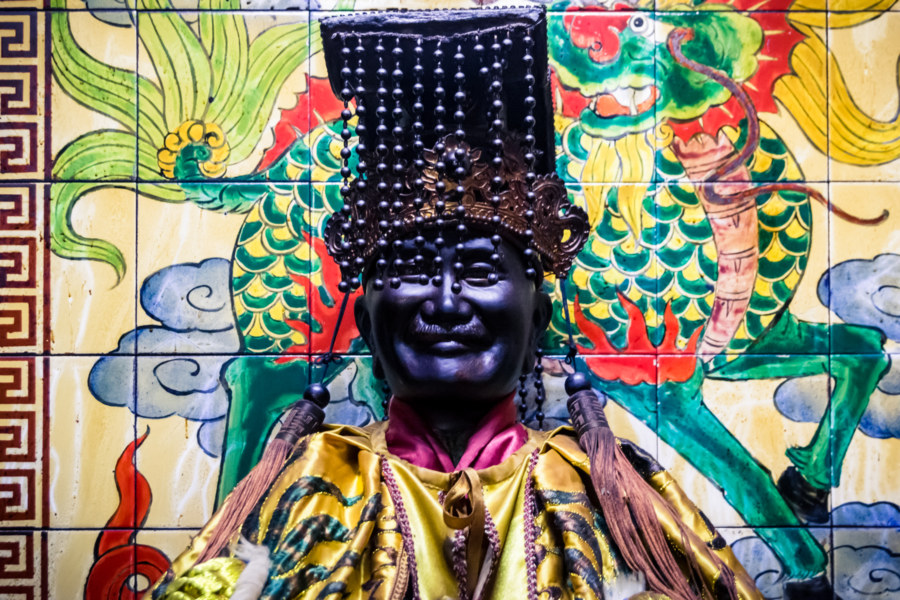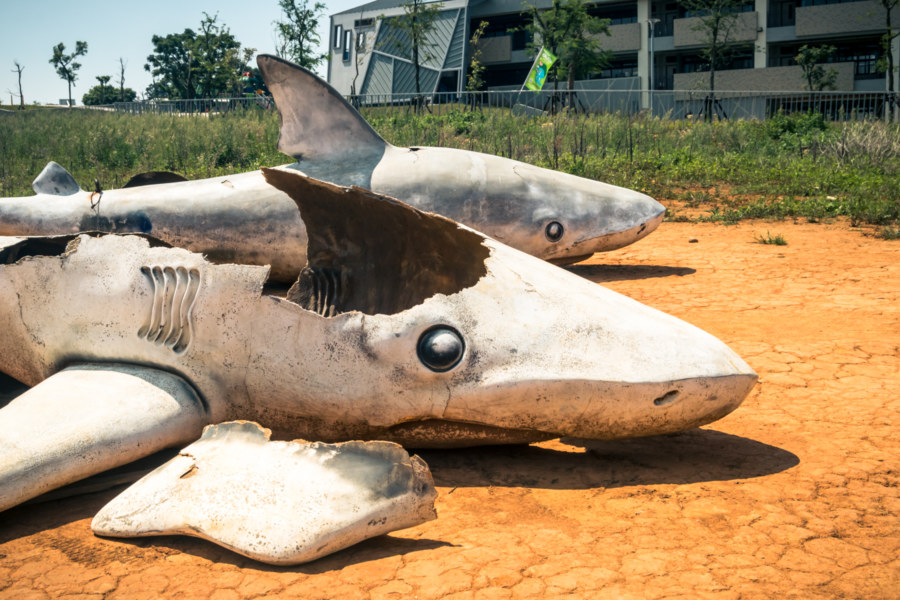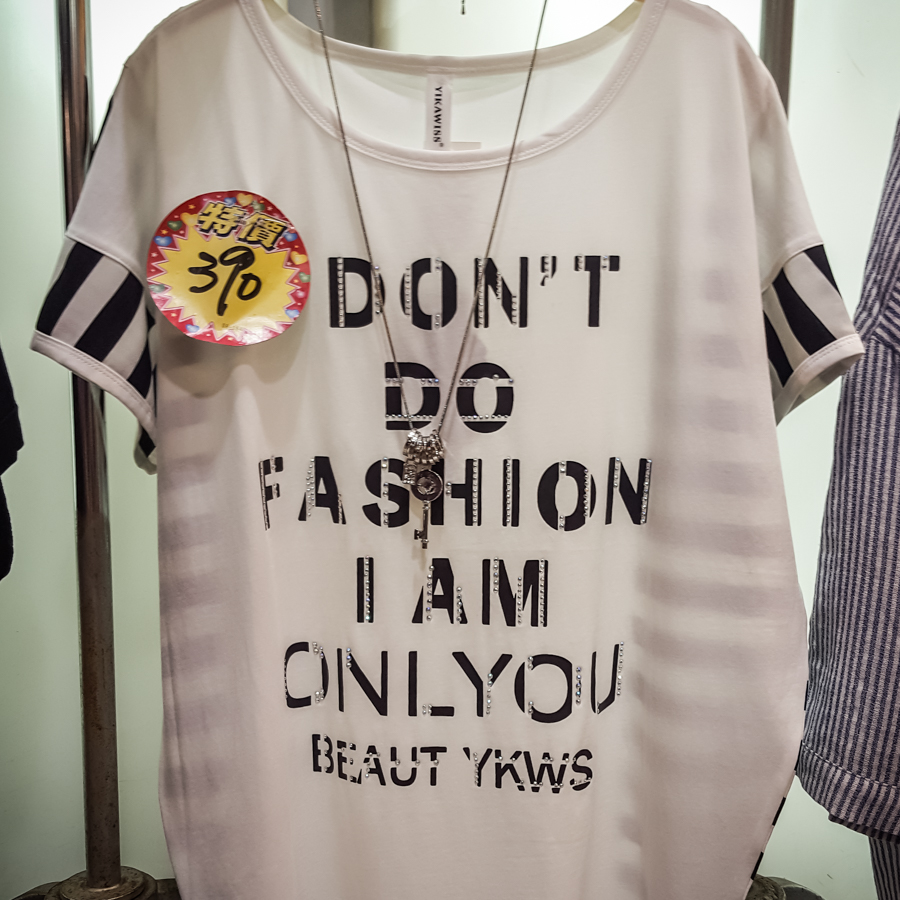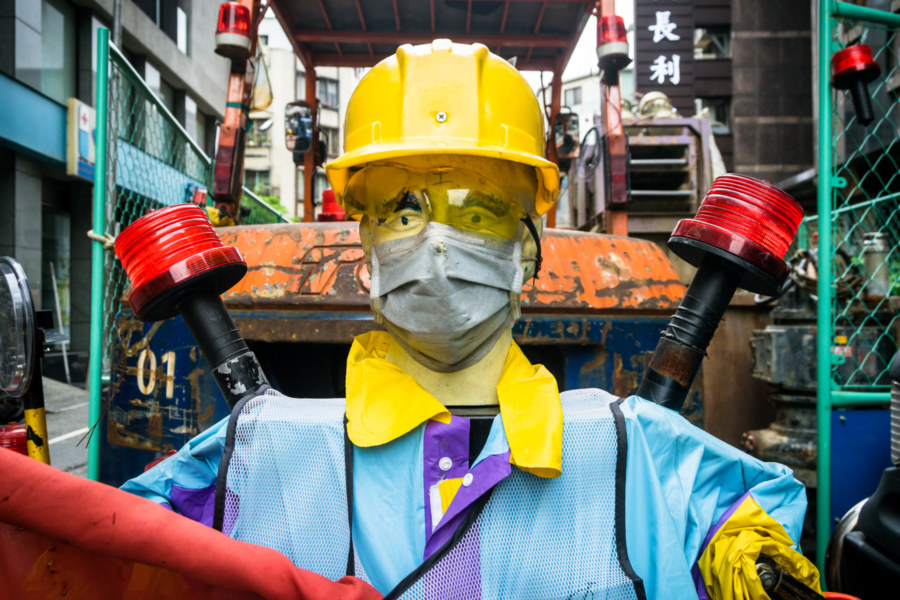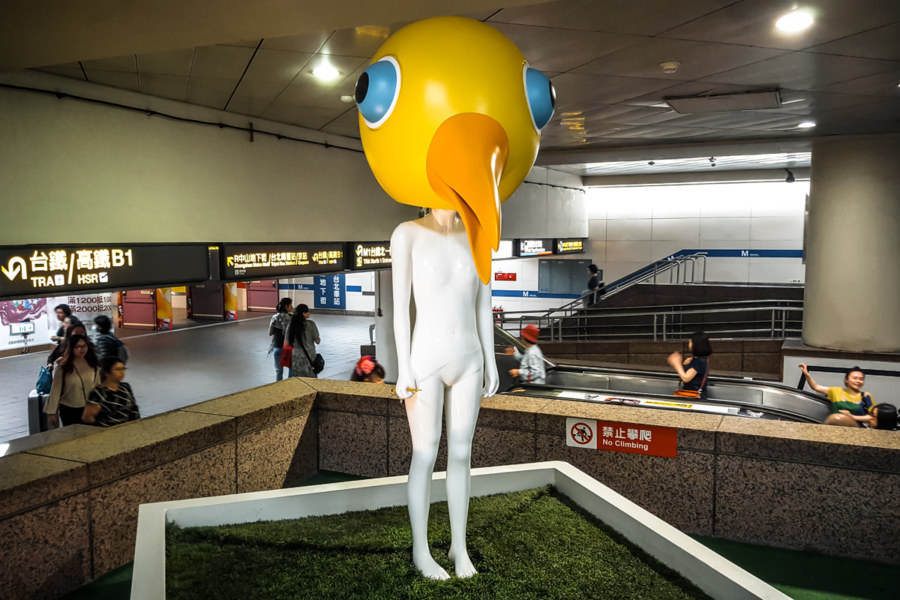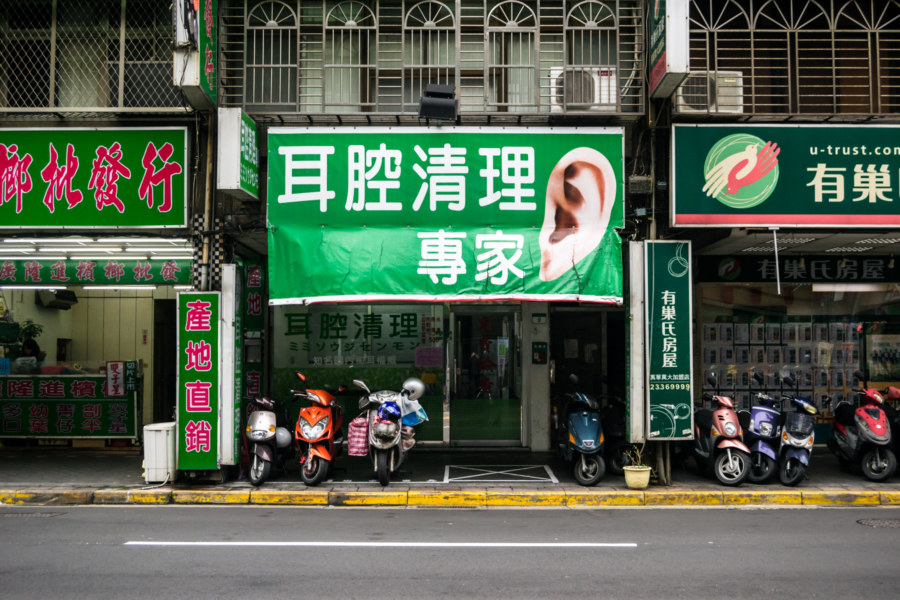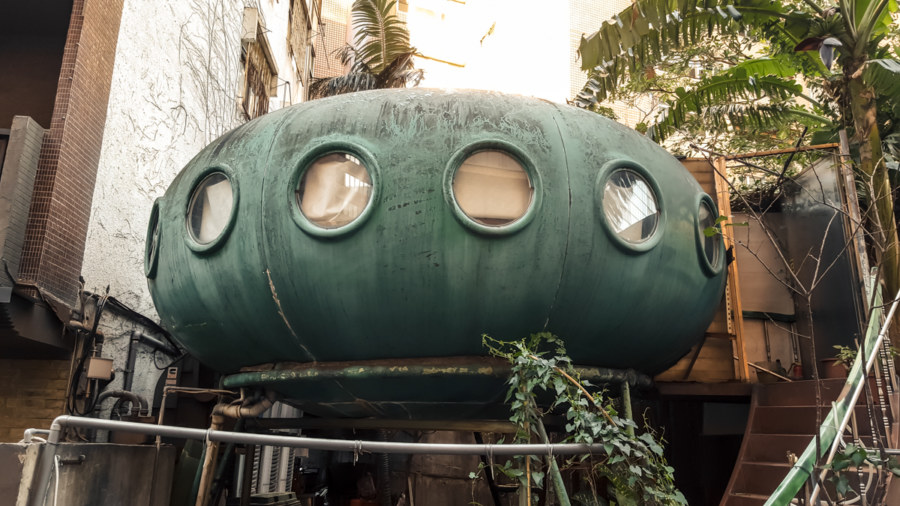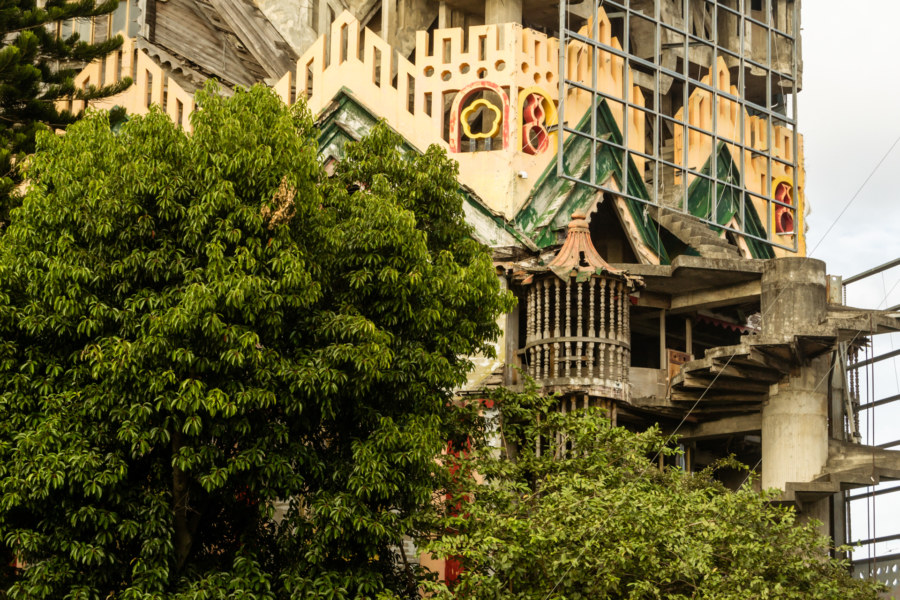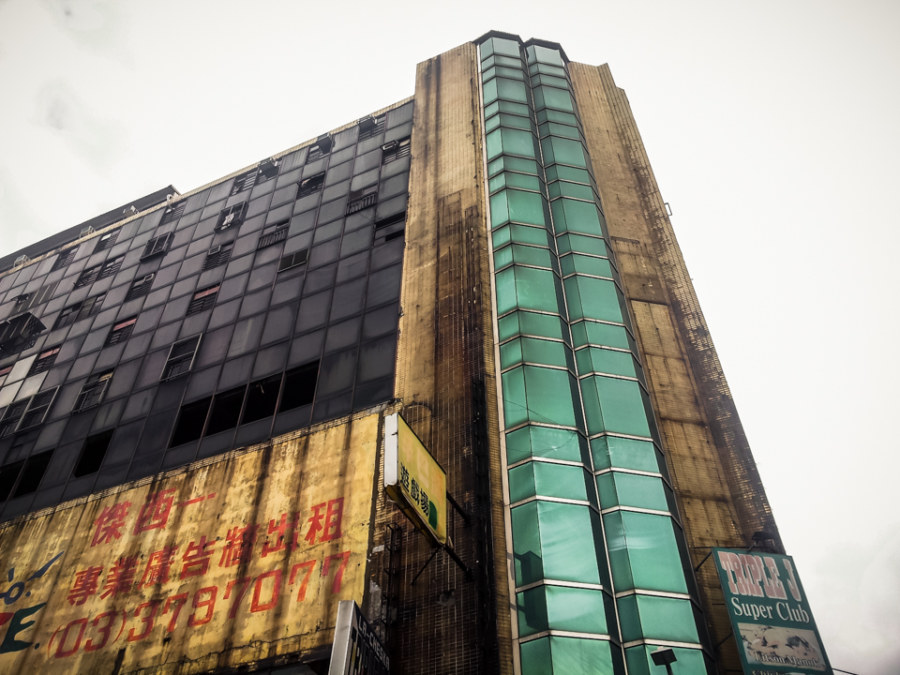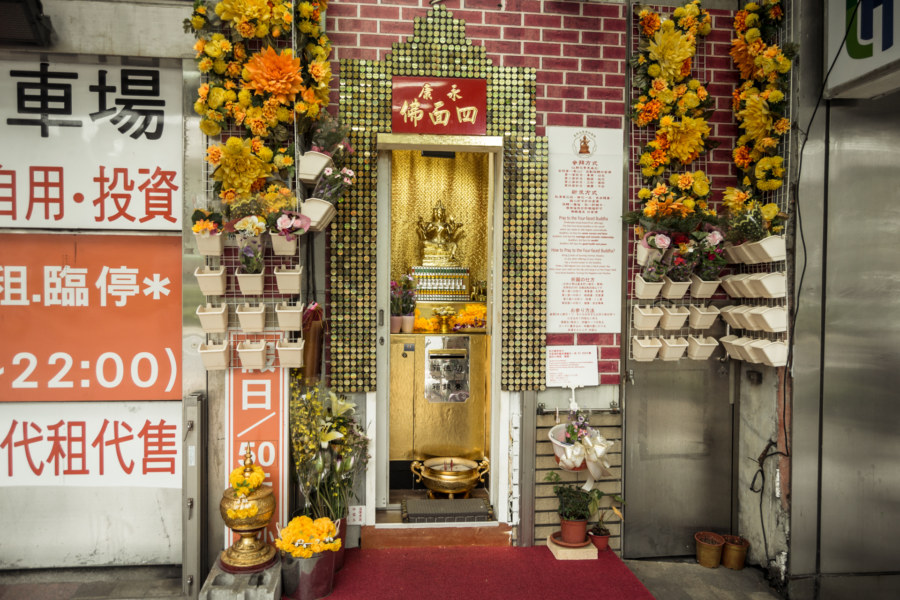Kuíxīng Temple 魁星宮 in Tamsui is nominally dedicated to the eponymous Kuíxīng 魁星, god of examinations and one of the Five Wénchāng 五文昌, a group of deities representative of classical Chinese culture. He typically takes the form of a man balanced on one foot with a writing brush in one hand, his body twisted in a pose suggestive of the strokes of Chinese calligraphy. But you didn’t come here to read about Kuixing—this temple is notable for being one of only a handful of sites in Taiwan venerating Chiang Kai-shek 蔣中正, president of the Republic of China until his death in 1975, as a god. For a time it was informally known as the Tamsui CKS Temple 淡水蔣中正廟.
"Weird" is a catch-all term referring to anything strange, unusual, awful, or unintentionally funny that seems to fit with what else you'll find here. See also: creepy, amusing, and absurdity.
Taichung Shark Cemetery 台中鯊魚墳場
Taichung Shark Cemetery (台中鯊魚墳場) is an unlikely roadside attraction near Tunghai University (東海大學) in Xitun, Taichung. There is no great mystery here—a nearby restaurant and banquet hall by the name of Tong Hai Fish Village (東海漁村) dumped a bunch of junk in this farmer’s field sometime prior to 2009, and since then it has become a popular place for young Taiwanese to visit and take photos.
Taiwan Night Market Fashion 1
In addition to their reputation for novelty foods night markets in Taiwan also offer an almost endless variety of cheap goods, particularly clothing and accessories. Much of Taiwanese night market fashion is amusing, quirky, provocative, bizarre, or even incoherent, though some of it is also quite clever. My understanding is that a lot of the weirder stuff originates in China, where massive factories churn out garments emblazoned with English text and pop culture references without regard for semantic meaning. This is almost certainly the result of copying passages from print or online media, using machine translation, or sheer laziness, but it might also be for aesthetic effect. Transcription errors are common, particularly when popular designs are copied by competing factories. Observed on the scale of years there is something almost evolutionary at work in night market fashion—styles mutate and are subject to a kind of natural selection. To celebrate the absurdity of this curious cultural phenomena I have assembled about 40 photos from my many visits to the night markets of Taiwan, almost all of which I have previously been shared on my Instagram account, the perfect vehicle for such inanity. Enjoy!
Taiwan Road Safety Dummies 1 台灣的工程用假人一號
Road safety dummies are a distinctive feature of the streets of Taiwan. In Chinese they are generally known as engineering dummies 工程用假人 (pinyin: gōngchéngyòng jiǎrén), warning dummies 警示假人 (jǐngshì jiǎrén), or, more formally, electric flag-bearers 電動旗手 (diàndòng qíshǒu). According to law these robotic figures must be setup at all roadside construction sites to provide some measure of protection for workers as well as warn passing motorists and pedestrians of potential hazards. When hooked up to a car battery their stubby arms pump up and down, waving flags and other objects to direct traffic. Construction companies typically decorate these dummies with safety vests and hardhats, though it is not common for workers to express some creativity and personalize their dummies. Some of them even have individual names and histories! The rest of this post features photographs of some of the many road safety dummies I have encountered over the years.
The Birdman of Taipei Station
A bizarre work of public art in the bowels of Taipei Station.
This striking installation is one of the more iconic and well-known works of public art in Taipei. Created by artists Hé Cǎiróu 何采柔 and Guō Wéntài (郭文泰) in 2009, it is entitled The World in Aves’ Eyes (愛維思看世界), Birdperson (鳥人), or Daydreams (夢遊) and can be found somewhere in the labyrinthine passageways beneath Taipei Railway Station (臺北火車站). Apart from the obvious, the immature, androgynous figure holds a pencil in its right hand (never to write a word), water continuously seeps from its neck, and its feet show the signs of a mild case of pigeon toe, a condition that should be familiar to anyone who has seen young Taiwanese posing for photographs. Here is the original creative statement that accompanies the piece:
「愛維思看世界」以稚嫩的身體、怪誕逗趣的鳥頭以及輕輕淺淺的流水,表現出E世代對世界的困惑,身體的稚嫩感彷彿要告訴世界,還不急著要長大,而側著的鳥頭以不成比例的尺寸,誇張的標明著自我的異化感,猶如一位誤闖地球的外星人,在幽浮般的蛋殼中孵化而出。愛維思(Aves)搖搖晃晃的嘗試著適應這難以理解的世界,那漾漾清水則是一般腦傾洩而出的困惑,沒有黑暗、邪惡、憂傷或者種種成人世界裡的光怪色彩,愛維思(Aves)的苦惱是屬於孩童一般的天真困惑,在陽光的照耀下甚至會散射出七彩的光暈、迷霧而迷人。
My ability to translate Chinese remains limited, particularly when it comes to the sort of conceptual language employed above, but I’ll do my best to provide the gist. From what I can tell…
Clean Your Head
Here’s something you might not have seen before: a professional ear cleaning service in Wanhua! When I shot this photo while riding around a couple of months ago I assumed it was a run-of-the-mill ear, nose, and throat doctor with a quirky sign out front. Turns out this is a famous shop by the name of Ěrqiāng Qīnglǐ de Jiā (耳腔清理的家, loosely: “Ear Canal Cleaning Home”) where you can have your ears cleaned by a “professional ear cleaning master” (zhuānyè tāo’ěr shī 專業掏耳師) for about 500 NT. Apparently Yáo Bīn (姚賓), the octogenarian proprietor, will be happy to show off jars filled with grotesque things he has unearthed over the course of five decades of aural spelunking.
Da’an UFO House 大安飛碟屋
Taiwan has an unusual fixation on UFO houses. Browse around the web and you’ll invariably encounter references to the famous UFO resort in Sanzhi, demolished long ago in 2009. Keep digging and you might read about a second UFO resort in Wanli, still extant and the subject of a future post. But there’s more—and you don’t even have to leave Taipei city limits to find another example of this peculiar architectural fetish.
Longtan Monster House 龍潭怪怪屋
Longtan Monster House (龍潭怪怪屋) is a notorious architectural oddity on the northern edge of Longtan in Taoyuan, Taiwan. In Chinese it is also known as Yè Fābāo’s Monster House (葉發苞怪屋), after its owner and lead designer, and is officially named the Yeshan Building (葉山樓). It has been under construction for decades but at some point the money ran out and the owner has plastered it with advertisements, ostensibly to raise money to complete the project. Nowadays there is little to see beneath the incredible number of promotional banners hanging off the side of the building.
First Dispatch From Zhongli
Last week I moved from Taipei to Zhongli, a mid-sized city of approximately half a million1 about 45 minutes down the Western Line 西部幹線 in the heart of Taoyuan. I have been all around the island but haven’t explored much of what you might call the “middle north”, the strongly Hakka-influenced area stretching from the rugged borders of New Taipei south to Taichung that includes Taoyuan, Hsinchu, and Miaoli. Perhaps by staying here awhile I will find opportunities to explore more of this part of Taiwan and fill in some blank spots on my personal map.
The Four-Faced Buddha of Yongkang Street 永康街四面佛
The Four-Faced Buddha of Yongkang Street 永康街四面佛 is one of the smallest shrines I have ever seen in Taiwan. It occupies a tiny alcove next to an underground parking garage on Xinyi Road 信義路 east of Dongmen Station 東門站 exit 5 and the original Din Tai Fung 鼎泰豊. This alcove might have been a parking attendants’ booth prior to automating the entire system, although this is not explicitly stated in the material I have reviewed. From what I gather this shrine is the work of a local papaya milk vendor by the name of Mr. Lin. Despite its diminutive size—half a square meter according to some reports—the cost of rent is in excess of 10,000 NT per month!
